 | |
 Shown within Turkey | |
| Location | Mersin Province, Turkey |
|---|---|
| Coordinates | 36°29′00″N 33°33′00″E / 36.483333°N 33.55°E |
| Type | Settlement |
| History | |
| Periods | Bronze Age, Iron Age, Hellenistic, Roman, Byzantine |
| Cultures | Hittite |
| Site notes | |
| Excavation dates | 1994-1997 2007-2011 |
| Archaeologists | Nicholas Postgate, Mark Jackson, |
| Condition | In ruins |
Kilise Tepe is a mound in Mersin Province, Turkey, just west of the Göksu River, lying 20 kilometers from Mut and 145 kilometers from Mersin. It was initially known as Maltepe which is actually the name of a site on the other bank of the river about four kilometers to the west. The original name of the mound is not known and Kilise Tepe in Turkish means "church-hill" referring to a church ruin. The site is thought to have been part of the land of Tarḫuntašša, formed when Muwatalli II moved the Hittite capital.[1]
History

The earliest settlement is dated to third Millennium BC during the Early Bronze Age. During the Hittite Empire era, it was used to control the road between the Hittite lands in Central Anatolia and the Mediterranean ports.[2] At the end of the 13th Century BC, the settlement was burnt down by Sea peoples, like much of Anatolia at the time. In its wake, a reconstruction began, but this too was destroyed in the middle of the 12th Century BC.[3][4] Mycenaean LHIIIC pottery from Cyprus and Crete[5] was found in this layer, dating from 1200 to 1150 BC. During a two century break between the Iron Age and Hellenistic Period the site was unoccupied. Settlement resumed during the Hellenistic period, but there is no indication of a settlement during the Roman period. The ruined Byzantine church (single chamber with cemetery) is a circa 11th century replacement for a destroyed earlier 5th century Cilician three-aisled basilica (with side chambers and a passage to the east of the apse).[6][7]
Excavations
The site was first report in 1958 by J. Mellaart who noted large amounts of pottery from the 3rd, 2nd, and 1st Millenniums BC.[8] It lies on a 200 meter north to south promontory and is 100 meters by 120 meters in extent with a height from 10 to 12 meters with the northern portion somewhat higher.
In response to dam construction, excavations began in 1994 as a joint effort between Cambridge University and Newcastle University and continued until 1997. The work began with a fiull mapping survey in 1994. In the Late Bronze layer (Level III) some timbers were recovered which gave a dendrochronology date of 1380 BC. Level II produced 4 lentoid stamp seals typical of 13th century BC Hittite Empire. One is of an official reading, in hieroglyphs, "Tarhunta-piya, the charioteer".[9][10][11][12][13][14][15] After a pause the excavations resumed in 2007 focusing on Late Bronze Age and later levels.[16][17][18] The Cambridge team is headed by Nicholas Postgate and is responsible for the Iron Age excavations. The Newcastle team is headed by Mark Jackson and is responsible for the Byzantine excavations. This work continued until 2011.[19] The Turkish collaborators were Çanakkale Onsekiz Mart University in the 2010–2011 term and Bitlis Eren University in later terms. The findings are exhibited in Silifke Museum.
See also
Notes
- ↑ Symington, Dorit. "Hittites at Kilise Tepe." Publications de l'Institut Français d'Études Anatoliennes 13.1 (2001): 167-184
- ↑ Mersin Ören Yerleri Kaleleri Müzeleri ISBN 978-605-4196-07-4, p 325
- ↑ Symington, Dorit (2001). "Hittites at Kilise Tepe". Publications de l'Institut Français d'Études Anatoliennes. 13 (1): 167–184.
- ↑ Hald, Mette Marie; Kozal, Ekin; Postgate, Nicholas; Miller, Bob. "Further work at Kilise Tepe, 2007-2011: refining the Bronze to Iron Age transition" (PDF).
{{cite journal}}: Cite journal requires|journal=(help) - ↑ Tomlinson, Jonathan E. "Comparison of the NAA Data for Six Mycenaean-style Samples from Kilise Tepe with Chemical Reference Groups from Mainland Greece, Crete, Cyprus and the Levant".
{{cite journal}}: Cite journal requires|journal=(help) - ↑ JACKSON, MARK. "2007–2011 Excavations at Kilise Tepe: A Byzantine Rural Settlement in Isauria." Dumbarton Oaks Papers, vol. 69, pp. 355–80, 2015
- ↑ Jackson M. “Byzantine Settlement at Kilise Tepe in the Göksu Valley”. In: Hoff, M., Townsend, R, ed. Rough Cilicia: New Archaeological and Historical Approaches. Oxford: Oxbow Books, 2013, pp.219-232
- ↑ J. Mellaart, "Second Millennium pottery from the Konya Plain and neighbourhood", Belleten, vol. 22, pp. 311-345, 1958
- ↑ H. D. Baker et al, Kilise Tepe 1994, Anatolian Studies, vol. 45, pp. 139-191, December 1995
- ↑ Postgate, J.N., Kilise Tepe 1994: A Summary of the Principal Results, Kazi Sonuçlari Toplantisi I, vol. 17, pp. 419-431, 1996
- ↑ Postgate, J.N., Kilise Tepe 1995: A Summary of the Principal Results, Kazi Sonuçlari Toplantisi I, vol. 18, pp. 441-456, 1997
- ↑ Postgate, J.N., Kilise Tepe 1996: A Summary of the Principal Results, I, vol. 19, pp. 209-226, 1998
- ↑ Jackson, M.P.C. and J.N. Postgate, Kilise Tepe 1997: A Summary of the Principal Results, Kazi Sonuçlari Toplantisi I, vol 20, pp. 541-557, 1999
- ↑ Nicholas Postgate et al., Excavations at Kilise Tepe 1994–98, From Bronze Age to Byzantine in Western Cilicia: Volume 1. Text, BIAA Monograph Series, vol. 30.1, British Institute at Ankara, 2007 ISBN 9781902937403 eISBN 978-1-912090-58-7
- ↑ Nicholas Postgate et al., Excavations at Kilise Tepe 1994–98, From Bronze Age to Byzantine in Western Cilicia: Volume 2. Appendices, References & Figures, BIAA Monograph Series, vol. 30.2, British Institute at Ankara, 2007 eISBN 978-0-9954656-2-6
- ↑ Jackson M and Postgate N., Excavations at Kilise Tepe 2007, Kazi Sonuçlari Toplantisi, vol. 30, no. 3, pp. 207-232, 2009
- ↑ Collon D, Jackson M, Postgate N., Excavations at Kilise Tepe 2008, Kazi Sonuçlari Toplantisi, vol. 31, no. 1, pp. 159-184, 2009
- ↑ Jackson M and Postgate N., Excavations at Kilise Tepe, Kazi Sonuçlari Toplantisi, vol. 32, no. 3, pp. 424-446, 2010
- ↑ Christina Bouthillier et al, Further work at Kilise Tepe, 2007-2011: refining the Bronze to Iron Age transition, Anatolian Studies, vol. 64, pp. 95-161, 2014
Further reading
- Debruyne, Sofie. “Tools and Souvenirs: The Shells from Kilise Tepe (1994—1998).” Anatolian Studies, vol. 60, 2010, pp. 149–60
- C. K. Hansen and J. N. Postgate, The Bronze to Iron Age transition at Kilise Tepe, Anatolian Studies, vol. 49, pp. 111–122, December 1999
- Jackson, M., “Medieval Rural Settlement at Kilise Tepe in the Göksu Valley,” in Archaeology of the Countryside in Medieval Anatolia, ed. T. Vorderstrasse and J. J. Roodenberg (Leiden: NINO, 2009), 71–83
- J. N. Postgate, The Chronology of the Iron Age seen from Kilise Tepe, Ancient Near Eastern Studies, vol. 45, pp. 166–187, 2008